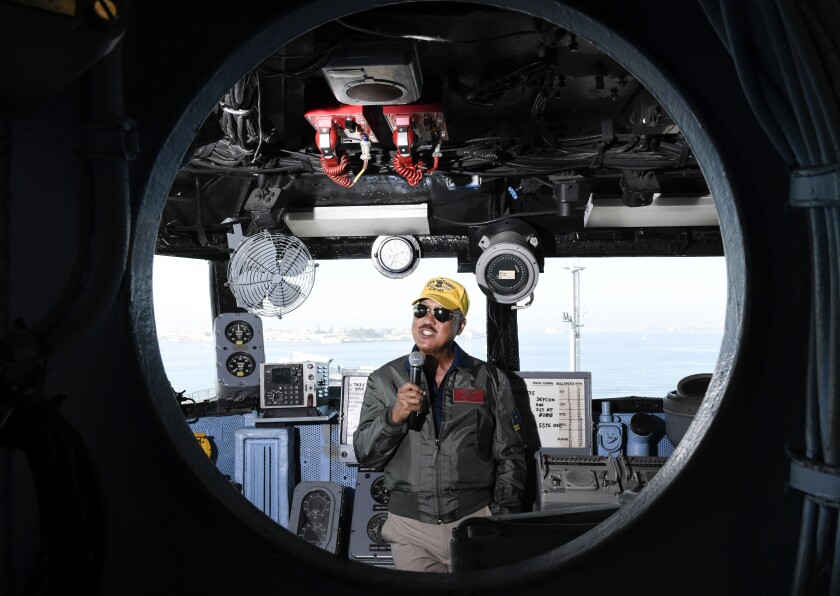Nguyen Dinh Nguyen poses for a photo on
the flight deck of the Midway next to a Huey helicopter on Nov. 13.
Nguyen flew Hueys and other aircraft during the Vietnam War.
(Denis Poroy)
Docent on Midway is a Vietnam War hero
Visitors to the USS Midway Museum in San Diego can usually find Nguyen Dinh Nguyen on the flight deck explaining how planes take off and land on the aircraft carrier. They may learn that Nguyen, 71, is a former pilot who landed planes on the Midway. What they won’t know is that Nguyen is a decorated war hero and military scientist with a dramatic and inspiring story.Nguyen was born in Hanoi, Vietnam, the oldest of five children. His father was a police chief. After the communists ousted France from North Vietnam and the country was split in 1954, the family was harassed and saw their freedoms eroded. “It was scary,” Nguyen recalled. “They were always watching us.”
In 1955, Nguyen and his family fled the North. As the oldest, Nguyen, who was then 7, helped bring his siblings out of Hanoi one-by-one, hiding money in sandwiches as they were searched at checkpoints. The family found their way to Saigon, South Vietnam.
While Nguyen was growing up in Saigon, the Vietnam civil war seemed remote. By the late 1960s that changed. “Before, we got shelled by rockets and ran for cover,” Nguyen explained. “Now we could see the enemy in the streets.”
In 1968, Nguyen joined South Vietnam’s Air Force. He was sent to the United States for pilot training. During the next seven years, Nguyen flew more than 9,000 air combat hours, rising to the rank of captain. Nguyen was shot down three times, suffering injuries including cracked vertebrae. Each time, he recovered, rejected a desk job and returned to combat. “That upset my mom,” he said.
Nguyen received two Silver Stars and three Bronze Stars from South Vietnam’s Air Force for his bravery in combat missions. He was one of only six Vietnamese pilots lent to the notorious CIA operation known as “Air America.” In 1970, he was awarded a Distinguished Flying Cross by the secretary of the U.S. Air Force for his role in rescuing U.S. POWs.
When the U.S. left Vietnam in April 1975, Nguyen airlifted some 400 Americans to safety, landing many of them on aircraft carriers, including the Midway. Not being a U.S. citizen, however, Nguyen was excluded from the manifest and could not remain on the carrier after his last flight.
Undeterred, Nguyen returned to Saigon — a city being overtaken by the enemy — commandeered a helicopter and flew himself and 14 family members out of Saigon. “It was chaotic. No law and order,” Nguyen recalls.
Nguyen and his family eventually made their way to Guam and became war refugees. The Salvation Army sponsored the family and relocated them to Idaho where Nguyen found work flying chartered planes.
However, Nguyen’s military career was far from over. After moving to San Diego and graduating from San Diego State University in 1981, Nguyen worked with the Air Force and Navy. He joined the Air Force Reserve in 1981, rising to the rank of major. He retired in 2004 after 23 years.

Nguyen Dinh Nguyen, a docent on the
Midway, leads a tour on Nov. 13, 2019 in San Diego, California. Nguyen
flew Huey’s and other aircraft during the Vietnam war.
(Denis Poroy)
Since his retirement from SPAWAR, Nguyen has volunteered most days as a docent helping visitors understand the USS Midway. He has a special feeling for the Midway given its role in Vietnam.
He also has a special feeling and deep appreciation for the United States. Nguyen and all 14 family members who accompanied him to America became naturalized U.S. citizens.
On the flight deck of the Midway, attached to a bench, there is a plaque that reads: “Many Thanks USA for Freedom, Hospitality and Opportunity [signed] Nguyen Dinh Nguyen (Aviator/Scientist/Docent) and 14 Family Members.”



/arc-anglerfish-arc2-prod-mco.s3.amazonaws.com/public/EFQKK3W2GFHX7ONQCN65NEMOUI.JPG)
/arc-anglerfish-arc2-prod-mco.s3.amazonaws.com/public/Z6M4TJX6HRFE3I7MOLQXSVLUXE.jpg)
/arc-anglerfish-arc2-prod-mco.s3.amazonaws.com/public/ZCW5SAEZ5VHADNM32FTK4NKECU.jpg)